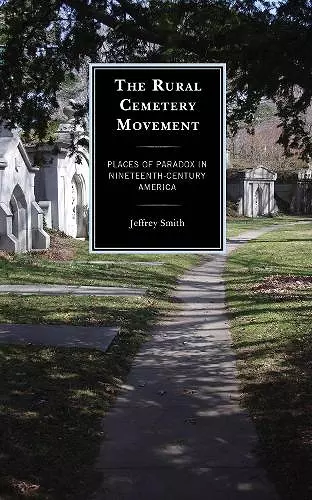The Rural Cemetery Movement
Places of Paradox in Nineteenth-Century America
Format:Hardback
Publisher:Lexington Books
Published:23rd Oct '17
Currently unavailable, and unfortunately no date known when it will be back
This hardback is available in another edition too:
- Paperback£36.00(9781498529020)

When Mount Auburn opened as the first “rural” cemetery in the United States in 1831, it represented a new way for Americans to think about burial sites. It broke with conventional notions about graveyards as places to bury and commemorate the dead. Rather, the founders of Mount Auburn and the spate of similar cemeteries that followed over the next three decades before the Civil War created institutions that they envisioned being used by the living in new ways. Cemeteries became places for leisure, communing with nature, and creating a version of collective memory. In fact, these cemeteries reflected changing values and attitudes of Americans spanning much of the nineteenth century. In the process, they became paradoxical: they were “rural” yet urban, natural yet designed, artistic yet industrial, commemorating the dead yet used by the living. The Rural Cemetery Movement: Places of Paradox in Nineteenth-Century America breaks new ground in the history of cemeteries in the nineteenth century. This book examines these “rural” cemeteries modeled after Mount Auburn that were founded between the 1830s and 1850s. As such, it provides a new way of thinking about these spaces and new paradigm for seeing and visiting them. While they fulfilled the sacred function of burial, they were first and foremost businesses. The landscape and design, regulation of gravestones, appearance, and rhetoric furthered their role as a business that provided necessary services in cities that went well beyond merely burying bodies. They provided urban green spaces and respites from urban life, established institutions where people could craft their roles in collective memory, and served as prototypes for both urban planning and city parks. These cemeteries grew and thrived in the second half of the nineteenth century; for most, the majority of their burials came before 1910. This expansion of cemeteries coincided with profound urban growth in the United States. Unlike their predecessors, founders of these burial grounds intended them to be used in many ways that reflected their views and values about nature, life and death, and relationships. Emphasis on worldly accomplishments increased with industrialization and growth in the United States, which was reflected in changing ways people commemorated their dead during the period under this study. Thus, these cemeteries are a prism through which to understand the values, attitudes, and culture of urban America from mid-century through the Progressive Era.
. . . this rich subject, and Smith’s research, merits the attention of a new audience. * Missouri Historical Review *
Smith (history, Lindenwood Univ.) approaches the 19th-century rural cemetery movement from the perspective of its paradoxes. Burial institutions evolved as remedies to overcrowding at the outskirts of rapidly growing cities, but eventually were overwhelmed by that growth. They mimicked an idyllic rural landscape while serving an urban community; performed both sacred and recreational functions; and were public spaces as well as private businesses. Smith surveys the tensions among these functions, using examples from cities including Boston, Brooklyn, Akron, Philadelphia, and St. Louis. While the landscape architecture aspects have been intensively examined elsewhere, and Smith reviews them here as well, his true contribution is his focus on the business aspects of rural cemeteries, how they were financed and maintained, and the implications for design inherent in the social class structure of the 19th century. The author details the choices made to serve wealthy elites, religious groups, the poor, and the burgeoning middle class, and explores the process of increasing regulation and standardization. Excellent bibliography…. Summing Up: Recommended. All academic libraries. * CHOICE *
This is a fascinating and well-written study. When Mount Auburn opened in 1831, it marked the beginning of the rural cemetery movement in America. With it, burial grounds became cemeteries—no longer simply places to bury a family’s nearest and dearest, but planned green spaces that celebrated the lives of their residents, functioned as parks for growing cities, and established a new business model for the country’s emerging economy. In his excellent book, Jeffrey Smith covers the history of these changes in a thoroughly engaging way. This book is a must-read for anyone interested in the America of the nineteenth century. -- Carol R. Yaster, President, Friends of Laurel Hill Cemetery
Jeffrey Smith detours from the well-trodden historiographical path of the rural/garden cemetery movement. Smith reinterprets this movement, showing how the rural/garden cemetery was not only cleverly used as a vehicle to engage the changing urban landscape of the nineteenth century, but ultimately served a puzzling but pertinent dual purpose—sacred and secular, natural and created. This excellent book is straightforward but skillfully crafted, making it a celebrated contribution to the field of cemetery studies and a must read for all who are curious about the ground where we all will one day rest. -- Kami Fletcher, Delaware State University
While many scholars have discussed rural cemeteries in broad swaths, no one until Jeffrey Smith has tried to fully detail the complexities and contradictions around nature, ornamentation, culture, and business that these cemeteries represent. In this well-researched and written history, Smith draws upon a wide range of national examples to illuminate this critical change in the American way of death. -- David C. Sloane, University of Southern California
ISBN: 9781498529006
Dimensions: 239mm x 157mm x 15mm
Weight: 422g
182 pages